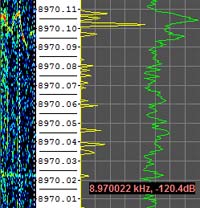13 Mar 2011
DJ8WX copied again on VLF (645km)
Uwe DJ8WX is currently transmitting a long dash on 8.90022kHz and his signal was copied well on my VLF grabber overnight in a 424uHz bandwidth. Also visible is a mystery signal around 8.9701kHz that most people think is some sort of local noise source but it is very repeatable every night.
12 Mar 2011
Monitoring 8.976607kHz for G3XIZ
Just back from a few days with our grandson and family and the PC is on looking for the latest VLF test from G3XIZ. Whilst I've been away I hear that OK2BVG has been received in the UK too on VLF. Activity on the Dreamer's Band (8-9khz VLF) is going from strength to strength with new stations getting active on RX and TX almost daily now in Europe.
10 Mar 2011
10m WSPR - reports from Australia today
 |
| WSPR reports 10.3.11 morning |
This morning my 5W WSPR signal on 28MHz reached Australia with reports from VK5ZK and VK6DZ. Best DX is 16275km, a new WSPR record for me on the band. In the last 3 months I've had WSPR reports from 6 continents. Not bad with 5W to a small wire halo antenna at this stage of the sunspot cycle. At 1100z I'd been received by no less than 4 different Australian stations plus Israel, the Faroes and UK.
DJ8WX on 8.970022kHz again
Just weak a very weak trace overnight (you have to look hard!) from DJ8WX on VLF. Compared with his signals a few days ago he is at least 10dB weaker. Not sure why as nothing has been changed here. G3ZJO also copied Uwe weaker than before, although Eddie was getting him slightly better than me using his E-field probe antenna. By the way, this small trace (in blue/white) covers a period of 8 hours and is looking for the signal in an incredibly narrow 424uHz (yes you read it correctly - microhertz) bandwidth.
9 Mar 2011
10m WSPR DX today
 |
| 28MHz WSPR reports today |
Whilst doing other work I left the 10m WSPR beacon system running today. Some decent DX about with the best being reports from FR1GZ and the two Israeli stations.
8 Mar 2011
Dazed goldfinch
 |
| One dazed little goldfinch with a headache! |
This little goldfinch crashed into our bedroom window yesterday morning. When I looked, he was just sitting on the roof very dazed. I opened the window, took this photo from about 10cm, stroked him ....and off he flew!
Labels:
goldfinch
Jazz at Ronnie Scotts in London
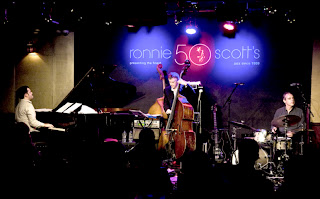 |
| Tim Lapthorn at Ronnie Scotts |
Our son Tim shown here on the piano at one of his many recent appearances at the world famous Ronnie Scotts jazz club in central London. His new album "Intentions" is due out later this year and will feature many of his new original compositions. See www.timlapthorn.com .
Labels:
jazz,
tim lapthorn
Latest NASA sunspot predictions
From the http://solarscience.msfc.nasa.gov/SunspotCycle.shtml website dated March 1st 2011:
"Current prediction for the next sunspot cycle maximum gives a smoothed sunspot number maximum of about 58 in July of 2013. We are currently over two years into Cycle 24. The predicted size would make this the smallest sunspot cycle in nearly 200 years."
Gloomy reading? Very recent solar levels in the last week or so may be just a blip, but something tells me we could all be in for a very big, and pleasant, surprise should activity continue to build as rapidly as it has recently. The sun is still full of surprises and no-one predicted the 2 year quiet sun we just had at the end of cycle 23.
I still find http://www.solen.info/solar/ the best page for up to date information on current solar activity.
Labels:
sunspots
6 Mar 2011
Doppler shift on 10m WSPR Transequatorial
This afternoon, before working some QRP DX on 10m and 12m SSB I had my WSPR system running and spotted FR1GZ (Reunion Is) several times at good levels. What was interesting was the Doppler shift on his signal which was up to -3Hz at times. I guess the propagation is trans-equatorial spread-F and what I'm observing are moving F-layers on the path between us.
Welcome back 10m "big time"
Today 10m sounded like the good old days with good strong contest signals from the USA and Canada as well as South America and Africa earlier in the day. I managed to work several stations in Texas, Alabama, Tennessee and Louisiana when running QRP SSB to the Homebase10 wire halo. This is the first time in around 5 years that I've heard the band like this. Welcome back good old 10m!
Labels:
10m,
6m qrp,
homebase10
A busy VLF amateur band (8-9kHz)
 |
| DK7FC's 8.97kHz grabber showing 4 stations active! |
This is REAL ham radio at the frontiers folks - put your cheque books away, forget those black boxes and join the fun on the Dreamer's Band.
Labels:
dreamers band,
vlf
5 Mar 2011
28MHz simple WSPR transceiver idea
Whilst playing with VXOs for my 10m DSB transceiver I realised that a cheap 14.060MHz crystal (available widely for about £1-2 each) would make a nice LO source for a 28MHz direct conversion WSPR transceiver. Doubled, the output is easily pulled to 28.1246MHz, the WSPR frequency. The PA does not have to be linear, so all that is needed apart from an oscillator/doubler is a single balanced mixer followed by a small PA. With the DSB approach, half the power is wasted and there would be an audio image 3kHz away on RX. However, the audio stages could be filtered to allow just 1.4-1.6kHz through. The whole transceiver could be extremely simple and stand-alone. I must build one.
ARRL SSB DX contest
Although there are US stations coming through on 15m, I've not yet heard any on 10m. Signals from LU1UM on 10m but nothing yet from North America. Sunspot count is high but conditions on 10m do not sound that good. Just worked N2PP on 15m SSB when using 10W to my 28MHz halo!
Labels:
arrl
VLF Dreamer's Band video
For those interested, I've made a short video showing my current VLF receiving set-up for 8.7-9.1kHz (antenna, matching, preamp, PC) used in the recent VLF reception tests in which G3XIZ has been copied twice now (45km), DJ8WX all of yesterday (645km) and DK7FC/P twice (629km). I am not claiming it to be fully optimised, but it certainly works.
What I like is that the wire antenna and the preamp cost a few pounds, the software is free (thanks Wolf) and the results mind blowing. In the near future I will try replacing the loop and preamp with a small E-field probe.
This is the link http://www.youtube.com/watch?
Also, G3XIZ was copied again on 9.0909kHz VLF at 45km. He was also copied by a few other UK stations including G3ZJO and M0BMU.
Labels:
8.97khz,
dreamers band,
g3xiz,
vlf
3 Mar 2011
DJ8WX received on 8.970022kHz
 |
| DJ8WX on 8.970022kHz VLF (645km) |
G3XIZ copied on VLF (at last)
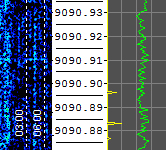 |
| G3XIZ received on VLF |
UPDATE: Paul Nicholson in Todmorden Yorks has confirmed he received Chris at a distance of 218km, a new record for a UK VLF ham station."You've re-awakened my enthusiasm which I must confess was fading. You are absolutely correct - I checked the transmitter about 02.30 and found that the aerial current had dropped off, maybe due to a change in loading coil inductance with temperature. I increased the drive and brought it back to the initial level of 0.18 A. You and I seem to be at the extreme range with my current set up and if the new loading coil is more efficient we must try the experiment again. I am pleased that the OCXO seems to stable enough for our purposes. Once I've cured my off air standard of losing 'lock' I'll use that as the frequency source. My TX input power was 120 watts giving an output RF of about 80 watts. This should automatically be increased with the better loading coil."
1 Mar 2011
International Short Wave League (ISWL)
It's the 65th anniversary of the ISWL this year. The ISWL is an international club for radio amateurs, shortwave listeners and broadcast band listeners from all over the world. They run a very wide range of contests covering all aspects of the hobby for both listeners and transmitting stations. Every month they produce a magazine filled with articles, reports and news items of interest. Subscription is just £20 a year and good value for a magazine running to around 60 pages every issue every month. For more details about joining this International Short Wave League see www.iswl.org.uk/. Also, look out for the club's special callsign GB65ISWL during the year ahead.
Labels:
iswl
28 Feb 2011
ARRL contest and re-erecting my X80 vertical
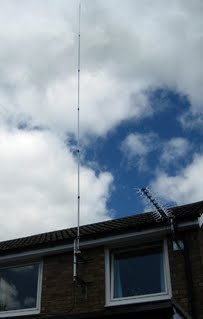 |
| SRC X80 multi-band vertical |
21 Feb 2011
The Tenbox - name chosen
Thanks for the suggested names for my 10m DSB project. The one that wins is the Tenbox, which is the logical name following on from my earlier AM transceiver projects called the Fredbox (2m) and the Sixbox (6m). The Tenbox is just right - a small box with a complete, yet simple, 10m sideband transceiver inside that should be completed in the next 4-6 weeks.
There will be no progress now for a week as my little 3 year old grandson is here to stay and he sleeps in the shack bedroom. Maybe I will teach him a little more CW.
There will be no progress now for a week as my little 3 year old grandson is here to stay and he sleeps in the shack bedroom. Maybe I will teach him a little more CW.
20 Feb 2011
More work on the 10m DSB rig
Today I continued breadboarding the TX strip of the 10m DSB transceiver changing the single balanced mixer to a broadband design and adding/changing stages in the driver and PA. After the mixer, the driver/PA design now has 2 transistors and 1 FET PA with an output of around 1W pep. This is not enough. My aim remains at least 2W pep either from this line-up (with an IRF510 PA) or with a different PA.
Incidentally, I need a name for this rig. I used the name "Tenner" for my 10m CW transceiver, so what shall I call this one? Please give me some ideas! DSB10? Sidebander10? 10phone?
Incidentally, I need a name for this rig. I used the name "Tenner" for my 10m CW transceiver, so what shall I call this one? Please give me some ideas! DSB10? Sidebander10? 10phone?
Labels:
10m,
28mhz,
dsb,
transceiver
19 Feb 2011
10m DSB rig progress (some)
Today I spent a little time on the transmit strip of my 10m DSB transceiver project. I started with the single balanced mixer using a T50-6 (yellow) toroid tuned to 10m, with LO injection from a signal generator and LF via a small audio preamp from an audio generator. For now I used a 1kHz tone to ensure drive levels were OK. Output is currently 20mW pep with 2 small 2N3904 linear stages following the mixer. To reach a useful RF level I therefore need another 20-23dB, easily done in two more stages. This would take me to around 2-3W pep.
17 Feb 2011
HE3OM on 137.7kHz this evening
HE3OM (Switzerland) is currently active during February using an old broadcast antenna 125m long vertical. Signals in Europe are very strong despite an ERP of just a few watts. This was the QRSS3 copy this evening using Spectran and receiving on a pair of untuned earth electrodes 20m apart directly into the FT817 which is deaf at 136-137kHz, i.e. no matching and no preamps.
Labels:
137khz
16 Feb 2011
70.210MHz test with M0AFJ
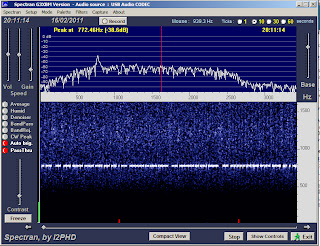 |
| M0AFJ's 4m CW at 75km tonight |
15 Feb 2011
4m transverter schematic
| 70MHz (4m) 1W pep transverter |
Labels:
4m,
70mhz,
qrp,
transverter
14 Feb 2011
My first 4m QSO this evening
Using my 70MHz homebrew transverter I managed my first ever 4m QSO using my own callsign this evening. I worked G6ALB on 70.2MHz SSB first and then we QSYed to 70.26MHz for an AM and an FM QSO. Reports both ways over our 3km path were fine even though we were cross-polarised. We invited others to join us, but no-one else was about. Years ago (1968) I did work ZB2VHF on 70.26MHz AM when running 4W from our university club station G3OUL.
Labels:
4m,
70mhz,
transverter
Signs of springtime
 |
| My wife Lis with the snowdrops and aconites |
Look at those sunspots!!!
This morning the sunspot count is at 84 with a solar flux level 107, the first time I've seen these figures in very many years. Already PA0O is being spotted by VK2KRR on the 10m band using WSPR. If numbers like these start to become more common, as they should during the climb up cycle 24, then 10m will be back to its old form with worldwide DX almost every day. Yippee!
Labels:
sunspots
13 Feb 2011
Simple Sideband QRP 10m transceiver started
A long overdue project of mine is a QRP 10m simple sideband (DSB) transceiver. Having got the 4m transverter working (circuit to follow) I'm now starting work on this project in time for the summer sporadic-E season. A website to track progress on this has been started. See a Simple Sideband 10m Transceiver. With any luck this will be breadboarded by mid-March. I have included lots of links to other 10m designs from which ideas will be (or have already been) gleaned.
New record on 30m WSPR
For a change this evening I put my 5W WSPR beacon on 30m (10MHz). To my surprise I got a report from VK7DIK at a distance of 17169km. This is a new distance record for my WSPR exploits. Others have, I know, managed this sort of DX with mW powers, something that I will have to try at some point.
11 Feb 2011
4m transverter boxed and finished (for now)
 |
| G3XBM 4m transverter - finished (for now) with 2-3W pep |
- IF breakthrough rejection at 28MHz is not brilliant, as one would expect from a single tuned circuit on the NE602 input. I can change the input to a top coupled pair to help, but will see how it behaves on-air first.
- LPF on the PA is just a single 3 component Butterworth. At some point I should add another section, but as the drivers/PA are linear all the way through, the 2nd/3rd harmonics should be reasonable already.
- The TX strip has DC power on it even on RX. I need to arrange to switch this off later, but I am not worried that there is another 50mA or so when on RX at the moment.
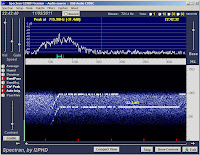 |
| GB3BAA 4m as received |
Labels:
4m,
70mhz,
transverter
10 Feb 2011
4m QRP transverter progressing well
 |
| 4m QRP transverter (so far) |
Labels:
4m,
70mhz,
transverter
9 Feb 2011
DK7FC's report on his 10th VLF test
This is an extract of the note from Stefan to the LF-reflector about his tests last weekend:
"Dear LF/VLF group and further VLF watchers :-)
After another very successful, exciting and fascinating /p VLF experiment i want, as usual, thank all the many (>=24) receiving stations who took the time to arrange a suitable antenna/receiver, PC and to watch the experiment and take some interesting captures. The transmissions took place on 2 VLF bands, 33km (8970 Hz) and 58km (5170 Hz).
So, thanks to TF3HZ, SQ5BPF, G4WGT, G3KEV, Daniele Tincani, G3WCD, G3XDV,M0BMU, G3XBM, OK2BVG, OE3GHB, G4AYT, IK1QFK, DL3ZID, F4DTL, OE5ODL, PA3CPM, PA3FNY, DL4YHF, DF6NM, DJ2LF, DD7PC (bold = 1st positive reception on VLF).
Special thanks to Halldor/TF3HZ who wasn't member of this group before but set up a very sensitive VLF receiver and even a most intersting grabber just by my email request. This is the first VLF detection between DL and TF. My signal appeared at up to 15 dB SNR in 4.5 mHz in 2404 km. This helps a bit to get some imagination how far a transatlantic detection is away.
Sorry to those who tried without success this time, like 4X1RF. The next experiment will come soon, maybe in about one month.
So, see you in the 11th experiment. :-)
Vy 73, Stefan/DK7FC'
8 Feb 2011
HamSphere internet ham radio system
 |
| How HamSphere works |
User interface is via a simulated HF transceiver presented on the computer screen. The "feel" of the transceiver is remarkably good. Of course, being an internet based virtual amateur radio system, no amateur radio equipment is needed and no RF is radiated, yet the experience is very close to that of operating a real HF radio on the HF bands. For those unable to operate real radios because of planning restrictions or other problems, this system offers some of the fun of amateur radio again. It is like CQ100, but in my opinion better.
The transceiver uses Java technology and simulates all amateur radio bands from 160 to 6 meters. The software, plus a lot more information about this service, is available from http://www.hamsphere.com/ . The software works in Windows, Mac and Linux.
Using the system I just had a QSO with ZS4CCM in South Africa. It felt like a real "on air" HF QSO. It's no substitute for the real thing, but fun to use on occasions and when HF conditions are appalling.
6 Feb 2011
DK7FC copied well here on 8.97kHz
After a few false starts and faulty kit, I managed good copy of Stefan DK7FC's signals on 8.97kHz this afternoon with my loop in the garden and this simple preamp into Spectrum Lab running on the PC. S/N was around 5-7dB in a 4.52mHz bandwidth. He was also copied in Iceland at over 2400kms.
5 Feb 2011
JT65A on HF
Having seen the article on how to do this in the latest edition of Practical Wireless, I have installed the software and taken a listen/look. Main issue seems to be that the AGC in the FT817 is fierce and with close-by PSK31 signals it kills the gain of weak JT65A signals nearby. Anyway, it looks a useful mode. For HF use, download the HF tailored version at http://jt65-hf.sourceforge.net/. Not yet had a 2-way QSO but will soon when I've got the hang of this.
DK7FC/P active on VLF this Sunday
Stefan plans to be out with his kite antenna and around 100mW ERP on the VLF bands this weekend from 0700-1630utc transmitting on 3 frequencies starting with 8.970000kHz. Progress can be monitored on his grabber located 40km from the /P location. I am hoping to copy Stefan on 8.97kHz again as I managed it back in December.
These grabbers will show when he is active:
8.97kHz http://www.iup.uni-heidelberg.de/schaefer_vlf/DK7FC_VLF_Grabber.html .
6.47kHz/5.17kHz http://www.iup.uni-heidelberg.
These grabbers will show when he is active:
8.97kHz http://www.iup.uni-heidelberg.de/schaefer_vlf/DK7FC_VLF_Grabber.html .
6.47kHz/5.17kHz http://www.iup.uni-heidelberg.
4 Feb 2011
4m transverter - stage 1
 |
| 4m converter breadboard (2N3904 oscillator and NE602) |
Next stage is to breadboard the TX mixer and buffer stages.
Labels:
4m
E-field probe test on 8.76kHz away from home
| G3XBM E-field probe for 8-9kHz |
1 Feb 2011
VLF earth-mode success: G6ALB copied at 3km on 8.76kHz
 |
| Spectran trace of G6ALB on 8.76kHz at 3km |
This is the first time I've received another amateur by earth-mode (conduction). The result suggests much further is possible. Experiments continue!
Labels:
8.76khz,
earth mode
PA1B analyses my 137kHz WSPR results
Bert PA1B has done some interesting "reverse analysis" of the WSPR reports I've given people. Working back from these you can estimate the lowest levels (in mW) that they could have used and still been copyable with me. This also gives a good guide to the likelihood of these stations receiving my weak signal. It is clear that M0BMU should be able to copy my 50uW ERP signal frequently (which he does) but that I'd need a lot more ERP to be able to get reports from the PA stations or SM6BHZ. See attached table from Bert.
Subscribe to:
Posts (Atom)
